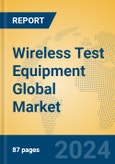Introduction
Wireless test equipment, comprising testing software, instruments, and microwave anechoic chambers/electromagnetic shielding boxes, is critical for validating the performance, interoperability, and compliance of wireless communication systems. This technology-intensive industry, with high entry barriers due to R&D, capital, and standards, is dominated by U.S. and Japanese firms like Keysight and Anritsu. Serving communications and electronics manufacturing, it supports telecom operators, equipment makers like Huawei, and device manufacturers like Apple. The global 5G rollout, with 4.25 million base stations in China (60% of global total) and 36 billion connections by Q2 2025, drives demand for testing system-in-package (SiP), modules, PCBs, and SMT processes. Applications include smartphones, IoT, and peripherals, with testing ensuring RF, protocol, and electromagnetic compatibility. The market faces challenges from high costs, supply chain disruptions, and evolving standards, but benefits from 5G, IoT, and automotive growth. Key players like Teradyne and Rohde & Schwarz lead, with Asia Pacific as the growth engine.Market Size and Growth Forecast
The global Wireless Test Equipment market is projected to reach a market size of 12.0-15.0 billion USD by 2025, with an estimated CAGR of 5%-7% through 2030. Growth is driven by 5G infrastructure, IoT adoption, and regulatory requirements.Regional Analysis
Asia Pacific is expected to grow at a CAGR of 6%-8%, led by China, South Korea, and Japan. China’s 4.25 million 5G base stations and electronics manufacturing hub drive demand, though trade restrictions pose risks. South Korea’s 5G device exports fuel testing, tempered by high costs. Japan’s telecom and IoT growth supports sales, constrained by labor shortages.- North America is projected to grow at a CAGR of 4.5%-6.5%, with the U.S. leading. The U.S. drives 5G and IoT testing, supported by Apple and Qualcomm, but faces chip shortages. Canada’s telecom upgrades support demand, limited by scale.
- South America is expected to grow at a CAGR of 3.5%-5.5%, with Brazil and Mexico contributing. Brazil’s 5G rollout drives testing, limited by economic volatility. Mexico’s electronics manufacturing supports growth, hindered by infrastructure gaps.
- The Middle East and Africa are projected to grow at a CAGR of 3%-5%, with the UAE and South Africa leading. The UAE’s smart city projects fuel demand, while South Africa’s 5G adoption supports growth, constrained by logistics.
Application Analysis
- Smartphones: Expected to grow at a CAGR of 5.5%-7.5%, driven by 5G device testing (36 billion connections). Trends focus on mmWave and multi-band validation, led by Huawei and Xiaomi.
- Tablets: Projected to grow at a CAGR of 4%-6%, with testing for Wi-Fi 6 and 5G. Growth is moderate due to limited innovation.
- Notebooks & Laptops: Expected to grow at a CAGR of 4.5%-6.5%, driven by Wi-Fi 6E and remote work. Testing ensures protocol compatibility.
- Peripherals: Projected to grow at a CAGR of 3.5%-5.5%, with testing for wireless mice and headsets. Growth is niche but steady.
- IoT: Expected to grow at a CAGR of 6.5%-8.5%, fueled by 30 billion devices by 2030. Testing focuses on low-power protocols like NB-IoT.
- Others: Projected to grow at a CAGR of 3%-5%, including automotive and aerospace testing. Trends emphasize V2X and satellite systems.
Type Analysis
- SiP: Expected to grow at a CAGR of 6%-8%, critical for integrated 5G chip testing. Trends focus on compact, high-frequency solutions.
- Module: Projected to grow at a CAGR of 5.5%-7.5%, used in IoT and smartphone modules. Testing ensures interoperability.
- PCB: Expected to grow at a CAGR of 4.5%-6.5%, vital for electronics manufacturing. Trends emphasize high-density board testing.
- SMT: Projected to grow at a CAGR of 4%-6%, used in surface-mount production. Testing ensures manufacturing precision.
- Others: Expected to grow at a CAGR of 3.5%-5.5%, including custom test setups. Growth is niche but stable.
Key Market Players
- Keysight Technologies: A U.S. company, Keysight offers scalable 5G and IoT test platforms, emphasizing automation.
- Rohde & Schwarz: A German firm, Rohde & Schwarz provides high-precision RF and network analyzers for telecom.
- Anritsu: A Japanese company, Anritsu delivers compact 5G and IoT test solutions, focusing on portability.
- Teradyne: A U.S. firm, Teradyne specializes in automated test equipment for SiP and semiconductors.
- National Instruments: A U.S. company, National Instruments offers modular test systems for wireless devices.
Porter’s Five Forces Analysis
- Threat of New Entrants: Low. High R&D, capital, and standards barriers, dominated by Keysight, limit entrants, though Chinese firms like Welzek enter with support.
- Threat of Substitutes: Low. Wired testing is impractical for wireless systems, ensuring demand for specialized equipment.
- Bargaining Power of Buyers: Moderate. Telecom giants like Huawei negotiate aggressively, but 5G testing’s complexity limits options for buyers.
- Bargaining Power of Suppliers: Moderate. Dependency on semiconductors and precision components increases supplier power, mitigated by Rohde & Schwarz’s integration.
- Competitive Rivalry: High. Keysight, Anritsu, and Teradyne compete on automation, precision, and cost, driving innovation but pressuring margins.
Market Opportunities and Challenges
Opportunities- 5G Expansion: 36 billion connections drive testing demand, benefiting Keysight and Teradyne.
- IoT Growth: 30 billion devices by 2030 require low-power testing, offering opportunities for National Instruments.
- Automotive Testing: V2X and ADAS testing create demand, benefiting Anritsu.
- Regulatory Needs: Stricter 5G standards in Europe and China support testing, benefiting Rohde & Schwarz.
- Emerging Markets: India’s 5G rollout drives affordable testing demand, benefiting Welzek.
- High Costs: Equipment prices ($50,000-$500,000) limit adoption, challenging Teradyne.
- Supply Chain Disruptions: Semiconductor shortages impact production, affecting Keysight.
- Evolving Standards: Rapid 5G/6G shifts require constant R&D, pressuring Anritsu.
- Geopolitical Tensions: U.S.-China trade issues disrupt supply chains, challenging Rohde & Schwarz.
- Talent Shortage: Complex testing requires skilled labor, impacting National Instruments’ growth.
This product will be delivered within 1-3 business days.
Table of Contents
Companies Mentioned
- Teradyne
- Rohde & Schwarz GmbH & Co. KG
- Anritsu Company
- Keysight Technologies Inc.
- National Instruments Corporation
- Welzek
- iTest








